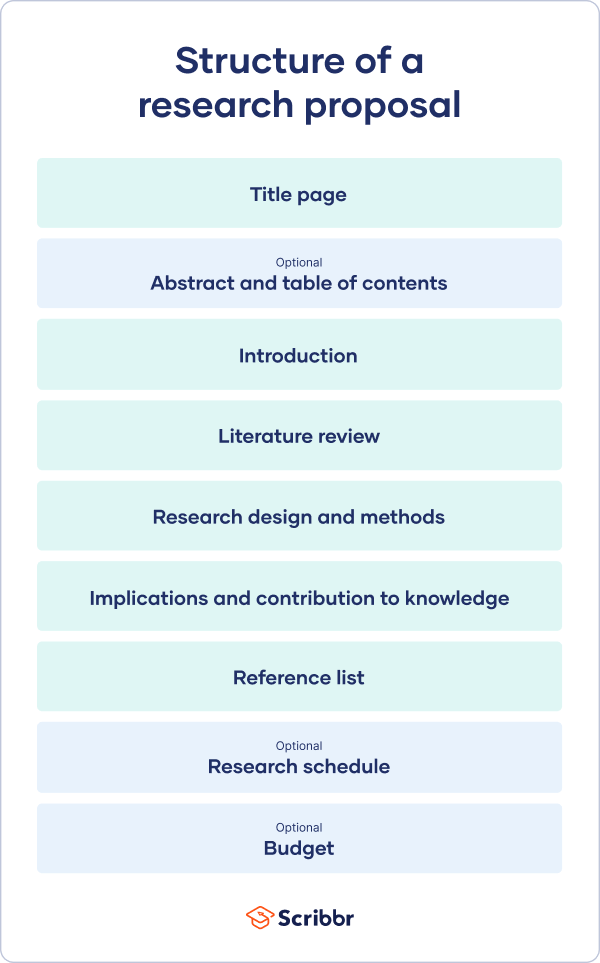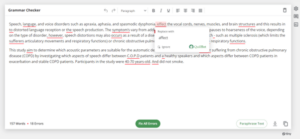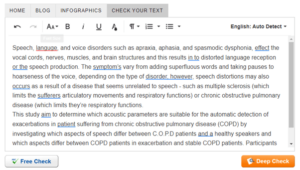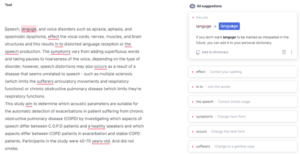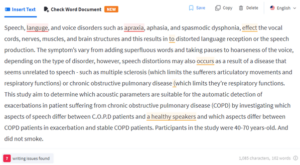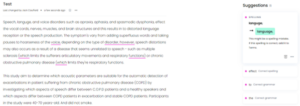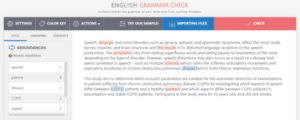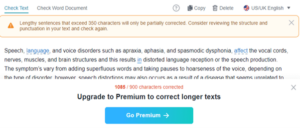The post How to Write a Research Proposal | Examples & Templates appeared first on Scribbr.
]]>A research proposal describes what you will investigate, why it’s important, and how you will conduct your research.
The format of a research proposal varies between fields, but most proposals will contain at least these elements:
While the sections may vary, the overall objective is always the same. A research proposal serves as a blueprint and guide for your research plan, helping you get organized and feel confident in the path forward you choose to take.
Research proposal purpose
Academics often have to write research proposals to get funding for their projects. As a student, you might have to write a research proposal as part of a grad school application, or prior to starting your thesis or dissertation.
In addition to helping you figure out what your research can look like, a proposal can also serve to demonstrate why your project is worth pursuing to a funder, educational institution, or supervisor.
| Relevance | Show your reader why your project is interesting, original, and important. |
| Context | Demonstrate your comfort and familiarity with your field. Show that you understand the current state of research on your topic. |
| Approach | Make a case for your methodology. Demonstrate that you have carefully thought about the data, tools, and procedures necessary to conduct your research. |
| Achievability | Confirm that your project is feasible within the timeline of your program or funding deadline. |
Research proposal length
The length of a research proposal can vary quite a bit. A bachelor’s or master’s thesis proposal can be just a few pages, while proposals for PhD dissertations or research funding are usually much longer and more detailed. Your supervisor can help you determine the best length for your work.
One trick to get started is to think of your proposal’s structure as a shorter version of your thesis or dissertation, only without the results, conclusion and discussion sections.
Download our research proposal template
Research proposal examples
Writing a research proposal can be quite challenging, but a good starting point could be to look at some examples. We’ve included a few for you below.
- Example research proposal #1: “A Conceptual Framework for Scheduling Constraint Management”
- Example research proposal #2: “Making Healthy Connections: Mentoring, Monitoring and Measurement”
- Example research proposal #3: “Medical Students as Mediators of Change in Tobacco Use”
Title page
Like your dissertation or thesis, the proposal will usually have a title page that includes:
- The proposed title of your project
- Your name
- Your supervisor’s name
- Your institution and department
Introduction
The first part of your proposal is the initial pitch for your project. Make sure it succinctly explains what you want to do and why.
Your introduction should:
- Introduce your topic
- Give necessary background and context
- Outline your problem statement and research questions
To guide your introduction, include information about:
- Who could have an interest in the topic (e.g., scientists, policymakers)
- How much is already known about the topic
- What is missing from this current knowledge
- What new insights your research will contribute
- Why you believe this research is worth doing
Literature review
As you get started, it’s important to demonstrate that you’re familiar with the most important research on your topic. A strong literature review shows your reader that your project has a solid foundation in existing knowledge or theory. It also shows that you’re not simply repeating what other people have already done or said, but rather using existing research as a jumping-off point for your own.
In this section, share exactly how your project will contribute to ongoing conversations in the field by:
- Comparing and contrasting the main theories, methods, and debates
- Examining the strengths and weaknesses of different approaches
- Explaining how will you build on, challenge, or synthesize prior scholarship
Research design and methods
Following the literature review, restate your main objectives. This brings the focus back to your own project. Next, your research design or methodology section will describe your overall approach, and the practical steps you will take to answer your research questions.
| Research type |
|
| Population and sample |
|
| Research methods |
|
| Practicalities |
|
Contribution to knowledge
To finish your proposal on a strong note, explore the potential implications of your research for your field. Emphasize again what you aim to contribute and why it matters.
For example, your results might have implications for:
- Improving best practices
- Informing policymaking decisions
- Strengthening a theory or model
- Challenging popular or scientific beliefs
- Creating a basis for future research
Reference list
Last but not least, your research proposal must include correct citations for every source you have used, compiled in a reference list. To create citations quickly and easily, you can use our free APA citation generator.
Research schedule
Some institutions or funders require a detailed timeline of the project, asking you to forecast what you will do at each stage and how long it may take. While not always required, be sure to check the requirements of your project.
Here’s an example schedule to help you get started. You can also download a template at the button below.
Download our research schedule template
| Research phase | Objectives | Deadline |
|---|---|---|
| 1. Background research and literature review |
|
20th January |
| 2. Research design planning |
|
13th February |
| 3. Data collection and preparation |
|
24th March |
| 4. Data analysis |
|
22nd April |
| 5. Writing |
|
17th June |
| 6. Revision |
|
28th July |
Budget
If you are applying for research funding, chances are you will have to include a detailed budget. This shows your estimates of how much each part of your project will cost.
Make sure to check what type of costs the funding body will agree to cover. For each item, include:
- Cost: exactly how much money do you need?
- Justification: why is this cost necessary to complete the research?
- Source: how did you calculate the amount?
To determine your budget, think about:
- Travel costs: do you need to go somewhere to collect your data? How will you get there, and how much time will you need? What will you do there (e.g., interviews, archival research)?
- Materials: do you need access to any tools or technologies?
- Help: do you need to hire any research assistants for the project? What will they do, and how much will you pay them?
Frequently asked questions about research proposals
- How do I write a research objective?
-
Once you’ve decided on your research objectives, you need to explain them in your paper, at the end of your problem statement.
Keep your research objectives clear and concise, and use appropriate verbs to accurately convey the work that you will carry out for each one.
Example: Verbs for research objectives I will assess …I will compare …
I will calculate …
- What’s the difference between research aims and objectives?
-
A research aim is a broad statement indicating the general purpose of your research project. It should appear in your introduction at the end of your problem statement, before your research objectives.
Research objectives are more specific than your research aim. They indicate the specific ways you’ll address the overarching aim.
- What is a PhD?
-
A PhD, which is short for philosophiae doctor (doctor of philosophy in Latin), is the highest university degree that can be obtained. In a PhD, students spend 3–5 years writing a dissertation, which aims to make a significant, original contribution to current knowledge.
A PhD is intended to prepare students for a career as a researcher, whether that be in academia, the public sector, or the private sector.
- What is a master’s?
-
A master’s is a 1- or 2-year graduate degree that can prepare you for a variety of careers.
All master’s involve graduate-level coursework. Some are research-intensive and intend to prepare students for further study in a PhD; these usually require their students to write a master’s thesis. Others focus on professional training for a specific career.
- What is critical thinking?
-
Critical thinking refers to the ability to evaluate information and to be aware of biases or assumptions, including your own.
Like information literacy, it involves evaluating arguments, identifying and solving problems in an objective and systematic way, and clearly communicating your ideas.
The post How to Write a Research Proposal | Examples & Templates appeared first on Scribbr.
]]>